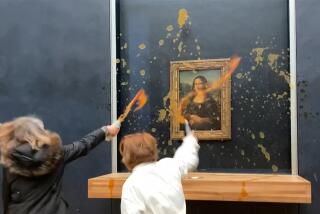A cultural agony in a nation where art is life
- Share via
Reporting from Port-Au-Prince, Haiti — At Port-au-Prince’s main art museum, it looked as if a cruel giant had taken bites out of the walls and ceiling of the cavernous exhibition hall.
Large wooden panels where paintings once hung had toppled. A bronze bust of DeWitt Peters, a California water colorist widely credited with bringing international attention to Haitian art in the 1940s, lay on the ground.
Joseph Gaspard, a member of the board of directors of the College Saint Pierre museum, was inspecting the site Saturday for the first time since the Jan. 12 earthquake, crunching broken glass as he walked through the debris. He struggled not to cry.
“Haitian art is what makes the international eye see us,” he said. “Every Haitian is an artist. Art, it is us, it’s what we are. Even our children are artists.”
With dozens of galleries, museums and other venues badly damaged in the quake, Haiti’s arts community is sick at heart. Had the nation’s rich cultural patrimony, a testament to joy and beauty in a land that has seen tragedy and despair, been lost?
Since the quake, gallery owners have been trying to pull together a list of artists killed, injured or missing. They’d accounted for about half of those they represented.
Untold is the toll in artworks, with their wild colors and real-life portrayals; their lions, tigers and bears, though those animals don’t exist in Haiti; their echoes of voodoo traditions and the nation’s African roots.
“It is difficult to talk about saving art when we must save lives,” said painter Maritou Chenet, whose oldest friends were killed in the disaster. But art is such an integral part of Haitian life that the works must be protected, she said, even as the buildings housing them are demolished.
Days ago, she watched as employees of the Centre d’Art used a long stick and fished to safety the Jasmin Joseph painting that dangled from the building’s ruined rafters. Then Chenet, 74, carefully removed the canvas from its frame, rolled the prized piece and hid it away for safekeeping.
“It was a big temptation,” Chenet, whose family has always been part of the Haitian art world, said of the valuable artworks that lay exposed in the Centre d’Art after the quake.
For more than half a century, the center symbolized the heart of Haiti’s world-famous art. It was here that artists in the 1940s were nurtured and eventually commercialized as perhaps the most successful ever Haitian export. Haitian oils and watercolors grace public and private collections the world over.
The facade of the building was sheared off in the magnitude 7.0 earthquake. Above mounds of fallen brick and fractured timber, paintings still hang precariously, the vivid blues and greens of iconic Haitian landscapes peeking through damaged walls.
Axelle Liautaud, an avid collector and renowned patron of the arts, is busily traveling from one damaged site to another. She personally salvaged several paintings at the College Saint Pierre, surveyed the priceless murals in the devastated Trinity Episcopal Church and is trying to help Chenet find tarps to protect what’s left of the Centre d’Art.
Liautaud is working with UNESCO, which assigned special envoy Bernard Hadjadj to the task of assessing damage and finding protection.
“Our cultural patrimony is at risk,” she said. “Thank God so many major pieces were out of the country.”
The Nader Art Gallery, considered the largest single collection of Haitian primitive art, a mecca for visitors who cherished its paintings and metal sculptures, collapsed. The Nader family escaped, but a maid was killed. The site looks like an archaeological dig, a mound of disaster covered in shards of ceramics and broken picture frames.
At the Monnin Gallery, a prominent center in the affluent suburb of Petionville, shellshocked artists streamed in Saturday to reconnect with patrons and be reminded that life would go on. In the gallery, paintings on the wall were askew, the force of the quake having turned them counterclockwise as they hung.
A collection of Bizango statues, representing the enforcers of the high priests of voodoo and made with real human skulls, had fallen to the ground.
“People are amazed that this incredible art comes from a country that is so poor and miserable,” said Gael Monnin, daughter of the gallery’s proprietor. “They live in terrible conditions but always depict such happy, colorful scenes.”
Mireille Delice is a well-known creator of the “flags,” or banners, a form of Haitian art that is a piece of cloth, usually satin, decorated with beads or sequins. In the quake she lost her sister, her house and her box of sequins.
“We have to keep on,” she said, seated at the gallery with other artists. Gabriel Coutard, a much sought-after painter, wandered in, in the same clothes he has been wearing since the quake. He seemed, still, stunned, unable to finish sentences.
“I have no idea what to do,” he said. “Art serves us. We must keep it.”
Inevitably, art has caught up to reality. Frantz Zephirin, whose work graces the cover of this week’s New Yorker, has already incorporated the earthquake in his art.
He ambled into the Monnin Gallery, his newest creation tucked under his arm.
It is a swirl of blue and green, with lots of eyeballs peering from the canvas, and a collection of outstretched hands reaching for help.
“I wanted to show Haitians in a sea of blood,” Zephirin said. But amid the hands in the sea of blood, Zephirin has painted “Haiti will reborn.”
More to Read
The biggest entertainment stories
Get our big stories about Hollywood, film, television, music, arts, culture and more right in your inbox as soon as they publish.
You may occasionally receive promotional content from the Los Angeles Times.











